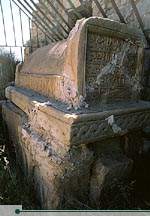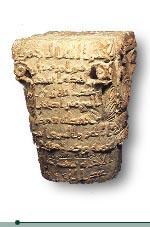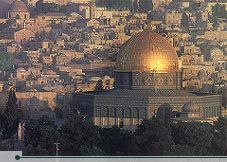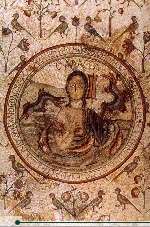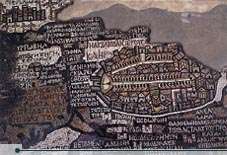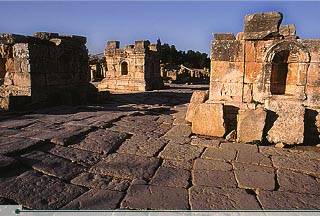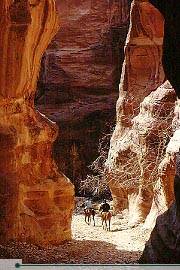The Mysterious Nabateans
Before Alexander’s conquest, a thriving new civilization had emerged in southern Jordan. It appears that a nomadic tribe known as the Nabateans began migrating gradually from Arabia during the sixth century BCE. Over time, they abandoned their nomadic ways and settled in a number of places in southern Jordan, the Naqab desert in Palestine, and in northern Arabia. Their capital city was the legendary Petra, Jordan’s most famous tourist attraction. Although Petra was inhabited by the Edomites before the arrival of the Nabateans, the latter carved grandiose buildings, temples and tombs out of solid sandstone rock. They also constructed a wall to fortify the city, although Petra was almost naturally defended by the surrounding sandstone mountains. Building an empire in the arid desert also forced the Nabateans to excel in water conservation. They were highly skilled water engineers, and irrigated their land with an extensive system of dams, canals and reservoirs. 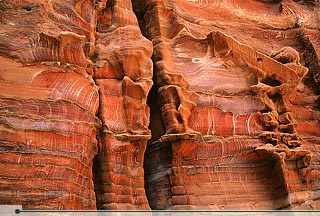
Close-up of red sandstone, Petra. © Michelle Woodward
The Nabateans were exceptionally skilled traders, facilitating commerce between China, India, the Far East, Egypt, Syria, Greece and Rome. They dealt in such goods as spices, incense, gold, animals, iron, copper, sugar, medicines, ivory, perfumes and fabrics, just to name a few. From its origins as a fortress city, Petra became a wealthy commercial crossroads between the Arabian, Assyrian, Egyptian, Greek and Roman cultures. Control of this crucial trade route between the upland areas of Jordan, the Red Sea, Damascus and southern Arabia was the lifeblood of the Nabatean Empire.
We still know comparatively little about Nabatean society. However, we do know that they spoke a dialect of Arabic and later on adopted Aramaic. Much of what is now known about Nabatean culture comes from the writings of the Roman scholar Strabo. He recorded that their community was governed by a royal family, although a strong spirit of democracy prevailed. According to him there were no slaves in Nabatean society, and all members shared in work duties. The Nabateans worshipped a pantheon of deities, chief among which were the sun god Dushara and the goddess Allat.
As the Nabateans grew in power and wealth, they attracted the attention of their neighbors to the north. The Seleucid King Antigonus, who had come to power when Alexander’s empire was divided, attacked Petra in 312 BCE. His army met with relatively little resistance, and was able to sack the city. The quantity of booty was so great, however, that it slowed their return journey north and the Nabateans were able to annihilate them in the desert. Records indicate that the Nabateans were eager to remain on good terms with the Seleucids in order to perpetuate their trading ambitions. Throughout much of the third century BCE, the Ptolemies and Seleucids warred over control of Jordan, with the Seleucids emerging victorious in 198 BCE. Nabatea remained essentially untouched and independent throughout this period.
Although the Nabateans resisted military conquest, the Hellenistic culture of their neighbors influenced them greatly. Hellenistic influences can be seen in Nabatean art and architecture, especially at the time that their empire was expanding northward into Syria, around 150 BCE. However, the growing economic and political power of the Nabateans began to worry the Romans. In 65 BCE, the Romans arrived in Damascus and ordered the Nabateans to withdraw their forces. Two years later, Pompey dispatched a force to cripple Petra. The Nabatean King Aretas III either defeated the Roman legions or paid a tribute to keep peace with them.
The assassination of Julius Caesar in 44 BCE augured a period of relative anarchy for the Romans in Jordan, and the Parthian kings of Persia and Mesopotamia took advantage of the chaotic situation to attack. The Nabateans made a mistake by siding with the Parthians in their war with the Romans, and after the Parthians’ defeat, Petra had to pay tribute to Rome. When they fell behind in paying this tribute, they were invaded twice by the Roman vassal King Herod the Great. The second attack, in 31 BCE, saw him take control of a large swath of Nabatean territory, including the lucrative northern trading routes into Syria.
Riding through the Siq, Petra.
© Jad Al Younis, Discovery Eco-Tourism
Nonetheless, the Nabateans continued to prosper for a while. King Aretas IV, who ruled from 9 BCE to 40 CE, built a chain of settlements along the caravan routes to develop the prosperous incense trade. The Nabateans realized the power of Rome, and subsequently allied themselves with the Romans to quell the Jewish uprising of 70 CE. However, it was only a matter of time before Nabatea would fall under direct Roman rule. The last Nabatean monarch, Rabbel II, struck a deal with the Romans that as long as they did not attack during his lifetime, they would be allowed to move in after he died. Upon his death in 106 CE, the Romans claimed the Nabatean Kingdom and renamed it Arabia Petrea. The city of Petra was redesigned according to traditional Roman architectural designs, and a period of relative prosperity ensued under the Pax Romana.
The Nabateans profited for a while from their incorporation into the trade routes of the Roman Near East, and Petra may have grown to house 20,000-30,000 people during its heyday. However, commerce became less profitable to the Nabateans with the shift of trade routes to Palmyra in Syria and the expansion of seaborne trade around the Arabian peninsula. Sometime probably during the fourth century CE, the Nabateans left their capital at Petra. No one really knows why. It seems that the withdrawal was an unhurried and organized process, as very few silver coins or valuable possessions have been unearthed at Petra.
français.....................................................................................................................................................
Les Nabatéens mystérieux
Avant la conquête d'Alexandre, une civilisation florissante nouvelle avait émergé dans le sud de la Jordanie. Il semble que une tribu nomade connu sous le nom des Nabatéens ont commencé à migrer progressivement de l'Arabie au cours du sixième siècle avant notre ère. Au fil du temps, ils ont abandonné leurs moyens nomades et sédentaires dans un certain nombre de places dans le sud de la Jordanie, le désert du Naqab en Palestine, et dans le nord de l'Arabie. Leur capitale était le légendaire Petra, en Jordanie attraction touristique la plus célèbre. Bien que Petra a été habitée par les Edomites avant l'arrivée des Nabatéens, ce dernier sculpté bâtiments grandioses, des temples et des tombes dans la roche de grès solide. Ils ont aussi construit un mur pour fortifier la ville, bien que Petra a été presque naturellement défendue par les montagnes de grès environnants. Construire un empire dans le désert aride a également forcé les Nabatéens à exceller en matière de conservation de l'eau. Ils étaient des ingénieurs hautement qualifiés de l'eau, et leurs terres irriguées avec un vaste système de barrages, de canaux et réservoirs
Les Nabatéens étaient exceptionnellement les commerçants qualifiés, faciliter le commerce entre la Chine, l'Inde, l'Extrême-Orient, l'Egypte, la Syrie, la Grèce et de Rome. Elles portaient sur des biens tels que les épices, l'encens, l'or, des animaux, de fer, le cuivre, le sucre, les médicaments, l'ivoire, des parfums et des tissus, pour n'en nommer que quelques-uns. Depuis ses origines comme une ville forteresse, Petra est devenu un carrefour riches commerciales entre l'Arabie, assyrienne, égyptienne, grecque et romaine cultures. Le contrôle de cette route commerciale cruciale entre les zones de montagne de la Jordanie, la mer Rouge, à Damas et l'Arabie méridionale était la pierre angulaire de l'Empire nabatéen.
Nous en savons encore relativement peu de choses sur la société nabatéenne.Cependant, nous savons que ils parlaient un dialecte de l'arabe et l'araméen a adopté plus tard. Une grande partie de ce qui est maintenant connu sur la culture nabatéenne provient des écrits de l'érudit romain Strabon. Il a enregistré que leur communauté a été gouverné par une famille royale, même si un fort esprit de la démocratie a prévalu.Selon lui, il y avait pas d'esclaves dans la société nabatéenne, et tous les membres partagent des prestations de travail. Les Nabatéens adoraient un panthéon de divinités, au premier rang qui étaient le dieu du soleil et de la Allat Dushara déesse.
Comme les Nabatéens ont augmenté en puissance et en richesse, ils ont attiré l'attention de leurs voisins du nord. Le roi séleucide Antigone, qui était venu au pouvoir quand l'empire d'Alexandre a été divisé, attaqué en 312 avant notre ère Petra. Son armée a rencontré une résistance relativement peu, et a pu mettre à sac la ville. La quantité de butin était si grande, cependant, qu'il a ralenti leur voyage de retour au nord et les Nabatéens étaient en mesure de les anéantir dans le désert. Les dossiers indiquent que les Nabatéens étaient impatients de rester en bons termes avec les Séleucides, afin de perpétuer leurs ambitions commerciales. Pendant une bonne partie de la troisième siècle avant notre ère, les Ptolémées et les Séleucides fait la guerre pour le contrôle de la Jordanie, avec les Séleucides en 198 en sortir victorieux BCE.Nabatea est demeurée essentiellement intacte et indépendant tout au long de cette période.
Bien que les Nabatéens résisté à la conquête militaire, la culture hellénistique de leurs voisins les ont influencés grandement. Influences hellénistiques peut être vu dans l'art et l'architecture des Nabatéens, en particulier au moment où leur empire était en expansion vers le nord en Syrie, autour de 150 avant notre ère. Cependant, la montée en puissance économique et politique des Nabatéens ont commencé à s'inquiéter des Romains. En 65 BCE, l'arrivée des Romains à Damas et a ordonné aux Nabatéens de retirer leurs forces. Deux ans plus tard, Pompée envoie une force de paralyser Petra.Le roi nabatéen Arétas III soit défait les légions romaines ou a rendu hommage à maintenir la paix avec eux.
L'assassinat de Jules César en 44 avant notre ère augure une période de relative anarchie pour les Romains en Jordanie, et les rois des Parthes de Perse et la Mésopotamie ont profité de la situation chaotique à l'attaque. Les Nabatéens fait une erreur en se rangeant avec les Parthes dans leur guerre avec les Romains, et après les Parthes défaite, Petra a dû payer tribut à Rome. Quand ils tombaient retard dans le paiement de cet hommage, ils ont été envahis deux fois par le vassal des Romains roi Hérode le Grand. La deuxième attaque, en 31 avant J.-C., le vit prendre le contrôle d'une large bande de territoire nabatéen, y compris des liaisons lucratives commerciaux du Nord en Syrie. Néanmoins, les Nabatéens ont continué à prospérer pendant un certain temps. Roi Arétas IV, qui régna de 9 BCE à 40 CE, a construit une chaîne de colonies le long des routes caravanières de développer le commerce de l'encens prospère. Les Nabatéens réalisé la puissance de Rome, et par la suite se sont alliés avec les Romains pour réprimer la révolte juive de 70 CE. Cependant, ce n'était qu'une question de temps avant Nabatea tomberait sous la domination romaine directe. Le dernier monarque nabatéenne, Rabbel II, a conclu un accord avec les Romains que tant qu'ils n'ont pas attaqué de son vivant, ils seraient autorisés à se déplacer dans après sa mort. À sa mort en 106 de l'ère, les Romains revendiqué du royaume nabatéen et l'a rebaptisé l'Arabie Pétrée. La ville de Petra a été remanié en fonction de conceptions architecturales traditionnelles romaines, et une période de relative prospérité s'ensuivit sous la Pax Romana.
Les Nabatéens profité pendant un certain temps de leur incorporation dans les routes commerciales de l'époque romaine Proche-Orient, et Petra peut avoir grandi dans la maison de 20.000-30.000 personnes à son apogée. Toutefois, le commerce est devenu moins rentable pour les Nabatéens avec le passage des routes commerciales à Palmyre en Syrie et à l'expansion du commerce maritime autour de la péninsule arabique. Parfois, probablement au cours du IVe siècle, les Nabatéens ont laissé leur capital à Petra. Personne ne sait vraiment pourquoi. Il semble que le retrait était un processus sans se presser et organisée, comme des pièces d'argent ou très peu de biens de valeur ont été découverts à Pétra.español.....................................................................................................................................................
Los nabateos misteriosas
Antes de la conquista de Alejandro, una nueva civilización próspera había surgido en el sur de Jordania. Al parecer, una tribu nómada conocida como los nabateos comenzaron a emigrar gradualmente de Arabia durante el sexto siglo AEC. Con el tiempo, abandonaron sus costumbres nómadas y se instalaron en una serie de lugares en el sur de Jordania, el desierto del Naqab en Palestina, y en el norte de Arabia. Su ciudad capital era la legendaria Petra, la más famosa atracción turística de Jordania.Aunque Petra fue habitada por los edomitas, antes de la llegada de los nabateos, la grandiosidad de los edificios, tallado, templos y tumbas en la roca arenisca sólida.Ellos también construyeron un muro para fortificar la ciudad, a pesar de Petra fue casi naturalmente defendido por las montañas de arenisca alrededor. La construcción de un imperio en el árido desierto también obligó a los nabateos para sobresalir en la conservación del agua. Eran ingenieros hidráulicos altamente calificados, y sus tierras de regadío, con un amplio sistema de presas, canales y embalses
El nabateos eran excepcionalmente comerciantes expertos, facilitar el comercio entre China, la India, el Lejano Oriente, Egipto, Siria, Grecia y Roma. Se trata de bienes tales como especias, incienso, oro, animales, hierro, cobre, azúcar, medicinas, marfil, perfumes y tejidos, sólo para nombrar unos pocos. Desde sus orígenes como una ciudad fortaleza, Petra se convirtió en un cruce de caminos comerciales entre los ricos del árabe, asirio, egipcio, griego y culturas romanas. El control de esta ruta del comercio entre las zonas altas de Jordania, el Mar Rojo, Damasco y el sur de Arabia era el alma del imperio nabateo.
Todavía sabemos relativamente poco sobre la sociedad nabatea. Sin embargo, sí sabemos que hablaban un dialecto del árabe y más tarde en arameo adoptado. Gran parte de lo que se conoce acerca de la cultura nabatea proviene de los escritos del erudito romano Estrabón. Dejó escrito que su comunidad estaba gobernada por una familia real, a pesar de un fuerte espíritu de la democracia prevaleció. Según él, no había esclavos en la sociedad nabatea, y todos los miembros comparten los derechos de trabajo. Los nabateos adoraban un panteón de deidades, jefe entre los cuales estaban el dios del sol y la Dushara Allat diosa.
A medida que los nabateos creció en poder y riqueza, que atrajo la atención de sus vecinos del norte. El seléucida Antígono rey, que había llegado al poder, cuando el imperio de Alejandro se dividió, atacó a Petra en el año 312 antes de Cristo. Su ejército se reunió con relativamente poca resistencia, y fue capaz de saquear la ciudad. La cantidad de botín era tan grande, sin embargo, que frenaron su viaje de regreso al norte y los nabateos fueron capaces de aniquilar en el desierto. Los registros indican que los nabateos estaban dispuestos a permanecer en buenos términos con los seléucidas con el fin de perpetuar sus ambiciones comerciales. A lo largo de gran parte de la III antes de Cristo del siglo, los Ptolomeos y Seléucidas pelearon por el control de Jordania, con los seléucidas de salir victorioso en 198 antes de Cristo. Nabatea permanecido esencialmente intacto e independientes a lo largo de este período.
A pesar de los nabateos resistido la conquista militar, la cultura helenística de sus vecinos que influyó en gran medida. Influencias helenísticas se puede ver en nabateo arte y la arquitectura, sobre todo en el momento en que su imperio se estaba expandiendo hacia el norte en Siria, alrededor de 150 antes de Cristo. Sin embargo, el creciente poder económico y político de los nabateos empezaron a preocuparse de los romanos. En el 65 aC, los romanos llegaron a Damasco y ordenó a los nabateos a retirar sus fuerzas. Dos años más tarde, Pompeyo envió una fuerza para paralizar Petra. El rey nabateo Aretas III derrotó a cualquiera de las legiones romanas o pagar un tributo para mantener la paz con ellos.
El asesinato de Julio César en el 44 aC auguraba un período de relativa anarquía de los romanos en el Jordán, y los reyes partos de Persia y Mesopotamia, se aprovechó de la situación caótica a los ataques. El nabateos cometió un error al ponerse del lado de los partos en su guerra con los romanos, y después de la derrota de los partos ', Petra tenía que pagar tributo a Roma. Cuando se atrasó en el pago de este tributo, fueron invadidos dos veces por el romano vasallo al rey Herodes el Grande. El segundo ataque, en el 31 aC, lo vio tomar el control de una amplia franja de territorio nabateo, incluyendo las rutas comerciales lucrativas en el norte de Siria.
Sin embargo, los nabateos continuó prosperando por un tiempo. Rey Aretas IV, que gobernó desde el 9 aC a 40 dC, construyó una cadena de asentamientos a lo largo de las rutas de las caravanas para desarrollar el comercio de incienso próspero. El nabateos dio cuenta del poder de Roma, y, posteriormente, se aliaron con los romanos para sofocar la sublevación judía de 70 EC. Sin embargo, era sólo cuestión de tiempo antes de Nabatea caería bajo el dominio directo de Roma. El último monarca nabateo, Rabbel II, llegó a un acuerdo con los romanos que, siempre y cuando no atacó durante su vida, se les permitiría avanzar en después de su muerte. A su muerte en 106 dC, los romanos reclamó el reino nabateo, y le cambió el nombre Saudita Petrea. La ciudad de Petra fue rediseñado de acuerdo a los diseños tradicionales de la arquitectura romana, y un período de relativa prosperidad se produjo bajo la Pax Romana.
Los nabateos se benefició por un tiempo de su incorporación a las rutas comerciales de la romana Cercano Oriente, y Petra puede haber crecido a la casa de 20.000-30.000 personas durante su apogeo. Sin embargo, el comercio se hizo menos rentable para los nabateos con el cambio de las rutas comerciales de Palmira, en Siria y la expansión del comercio marítimo alrededor de la península Arábiga. En algún momento, probablemente durante el siglo IV dC, los nabateos abandonaron su capital en Petra. Nadie sabe realmente por qué. Parece que la retirada fue un proceso pausado y ordenado, como monedas de plata muy pocos o posesiones valiosas han sido descubiertas en Petra.italiano......................................................................................................................................................
I Nabatei Mysterious
Prima della conquista di Alessandro, una civiltà fiorente nuova era emersa nel sud della Giordania. Sembra che una tribù nomade noto come i Nabatei cominciarono a migrare gradualmente dall'Arabia durante il sesto secolo aC. Nel corso del tempo, hanno abbandonato i loro modi nomade e si stabilì in un numero di posti a sud della Giordania, il deserto Naqab in Palestina, e nel nord Arabia. La loro capitale era la mitica Petra, attrazione turistica più famosa della Giordania. Anche Petra era abitata dagli Edomiti prima dell'arrivo dei Nabatei, il secondo scolpito grandiosi edifici, templi e tombe nella roccia arenaria solida. Hanno anche costruito un muro per fortificare la città, anche se Petra è stato quasi naturalmente difeso dalle montagne di arenaria circostanti. Costruire un impero nel deserto arido anche costretto i Nabatei per eccellere nella conservazione dell'acqua. Erano ingegneri idraulici altamente qualificati, e irrigate la loro terra con un ampio sistema di dighe, canali e bacini
Il nabatei era eccezionalmente abili commercianti, facilitare il commercio tra Cina, India, Estremo Oriente, Egitto, Siria, Grecia e Roma. Sono stati affrontati in tali merci come spezie, incenso, oro, animali, ferro, rame, zucchero, medicinali, avorio, profumi e tessuti, solo per citarne alcuni. Dalle sue origini come una città fortificata, Petra è diventata un crocevia ricchi commerciali tra l'arabo, assira, egizia, greca e cultura romana. Il controllo di questa importante via commerciale tra le aree montane della Giordania, il Mar Rosso, Damasco e Arabia meridionale è stata la linfa vitale dell'impero nabateo.
Sappiamo ancora relativamente poco Nabatean società. Tuttavia, sappiamo che parlavano un dialetto della lingua araba e in seguito ha adottato l'aramaico. Molto di ciò che ora è conosciuto sulla cultura nabatea proviene dagli scritti dello studioso romano Strabone. Ha registrato che la loro comunità era governata da una famiglia reale, anche se un forte spirito di democrazia ha prevalso. Secondo lui non c'erano schiavi in nabateo società, e tutti i membri condivisi in mansioni lavorative. I Nabatei adoravano un pantheon di divinità, i principali tra i quali il dio del sole e la Dushara Allat dea.
Come i Nabatei crebbe in potere e ricchezza, hanno attirato l'attenzione dei loro vicini del nord. Il re seleucide Antigono, che era venuto al potere quando l'impero di Alessandro fu diviso, attaccato Petra nel 312 aC. Il suo esercito ha incontrato resistenza relativamente poco, e fu in grado di saccheggiare la città. La quantità di bottino era così grande, tuttavia, che ha rallentato il loro viaggio di ritorno a nord e dei Nabatei erano in grado di annientarli nel deserto. Records indicano che i Nabatei erano desiderosi di rimanere in buoni rapporti con i Seleucidi, al fine di perpetuare le loro ambizioni commerciali. Durante gran parte del terzo secolo aC, i Tolomei e Seleucidi combattuto per il controllo della Giordania, con i Seleucidi uscire vittorioso nel 198 aC. Nabatea è rimasto sostanzialmente intatto e indipendente in tutto questo periodo.
Anche se i Nabatei resistito conquista militare, la cultura ellenistica dei loro vicini li hanno influenzati notevolmente. Influssi ellenistici può essere visto in nabateo arte e architettura, specialmente nel momento che il loro impero si sta espandendo verso nord in Siria, circa 150 aC. Tuttavia, il crescente potere economico e politico dei Nabatei ha cominciato a preoccuparsi Romani. Nel 65 aC, i Romani arrivarono a Damasco e ha ordinato i Nabatei di ritirare le loro forze. Due anni più tardi, Pompeo inviato una forza di paralizzare Petra. Il re nabateo Areta III sia sconfitto le legioni romane o pagate un tributo per mantenere la pace con loro.
L'assassinio di Giulio Cesare nel 44 aC auspicato un periodo di relativa anarchia per i Romani in Giordania, e il re dei Parti di Persia e di Mesopotamia ha approfittato della situazione caotica per attaccare. Il Nabatei commesso un errore schierarsi con i Parti nella loro guerra con i Romani, e dopo i Parti 'sconfitta, Petra ha dovuto pagare un tributo a Roma. Quando si passa in svantaggio a pagare questo tributo, furono invase due volte dal vassallo di Roma Re Erode il Grande. Il secondo attacco, nel 31 aC, lo vide prendere il controllo di una grande fetta del territorio nabateo, comprese le lucrose rotte commerciali del nord in Siria.
Tuttavia, i Nabatei continuarono a prosperare per un po '. Re Areta IV, che regnò dal 9 aC al 40 dC, costruito una catena di insediamenti lungo le rotte carovaniere per sviluppare il commercio prospera incenso. Il Nabatei realizzato il potere di Roma, e successivamente si allearono con i Romani per sedare la rivolta ebraica del 70 dC.Tuttavia, era solo una questione di tempo prima Nabatea sarebbe caduta sotto il diretto dominio romano. L'ultimo monarca Nabatean, Rabbel II, fece un patto con i romani che fino a quando non hanno attaccato durante la sua vita, che sarebbe stato permesso di muoversi in dopo la sua morte. Alla sua morte nel 106 dC, i romani rivendicato il regno dei Nabatei e la rinominò Arabia Petrea. La città di Petra è stato riprogettato secondo i tradizionali disegni romani di architettura, e un periodo di relativa prosperità seguì sotto la Pax Romana.
I Nabatei approfittato per un po 'dal loro inserimento nelle rotte commerciali dell'epoca romana Vicino Oriente, e possono Petra sono cresciuti a casa di 20.000-30.000 persone durante il suo periodo di massimo splendore. Tuttavia, il commercio è diventato meno redditizio per i Nabatei con lo spostamento delle rotte commerciali a Palmyra in Siria e l'espansione del commercio marittimo intorno alla penisola arabica.A volte probabilmente durante il quarto secolo dC, i Nabatei hanno lasciato la loro capitale a Petra. Nessuno sa veramente perché. Sembra che il ritiro è stato un processo lento e organizzata, come poche monete d'argento o oggetti di valore sono stati rinvenuti a Petra.....................................................................................................................................................................Die geheimnisvolle Nabatäer
Vor der Eroberung durch Alexander hatte eine blühende neue Zivilisation im südlichen Jordanien entstanden. Es scheint, dass ein Nomadenvolk der Nabatäer bekannt als die Migration nach und nach aus Arabien im sechsten Jahrhundert v. Chr. begann. Im Laufe der Zeit verlassen sie ihre nomadische Lebensweise und ließ sich in einer Reihe von Orten im südlichen Jordanien, die Naqab Wüste in Palästina und im nördlichen Arabien. Ihre Hauptstadt war der legendäre Petra, Jordanien berühmteste Touristenattraktion. Obwohl Petra wurde von den Edomiter vor der Ankunft der Nabatäer bewohnt, letztere grandiosen Bauten, Tempel und Gräber geschnitzt aus massivem Sandstein. Sie haben auch eine Mauer um die Stadt zu befestigen konstruiert, obwohl Petra war fast selbstverständlich von den umliegenden Bergen aus Sandstein verteidigt. Der Aufbau eines Imperiums in der trockenen Wüste zwang auch die Nabatäer zu übertreffen in Wasserschutzgebieten. Sie waren hoch qualifizierten Ingenieuren Wasser und bewässert ihr Land mit einem umfangreichen System von Dämmen, Kanälen und Stauseen
Die Nabatäer waren außerordentlich qualifizierten Händlern, Erleichterung von Handel zwischen China, Indien, dem Fernen Osten, Ägypten, Syrien, Griechenland und Rom.Sie befassten sich mit solchen Waren wie Gewürze, Weihrauch, Gold, Tiere, Eisen, Kupfer, Zucker, Medikamente, Elfenbein, Parfüms und Textilien, um nur einige zu nennen. Von seinen Ursprüngen als Festungsstadt, wurde Petra einem reichen kommerziellen Kreuzung zwischen der arabischen, assyrischen, ägyptischen, griechischen und römischen Kulturen. Die Kontrolle über diese wichtige Handelsroute zwischen den Berggebieten von Jordanien, dem Roten Meer, Damaskus und Südarabien war der Lebensnerv des Nabatäer-Reiches.
Wir wissen noch vergleichsweise wenig über Nabatean Gesellschaft. Aber wir wissen, dass sie einen Dialekt des Arabischen und später verabschiedet Aramäisch sprach.Vieles, was jetzt über Nabatean Kultur bekannt stammt aus den Schriften des römischen Gelehrten Strabo. Er notierte, dass ihre Gemeinde durch einen königlichen Familie regiert wurde, obwohl ein starker Geist der Demokratie durchgesetzt. Ihm zufolge gab es keine Sklaven in Nabatean Gesellschaft, und alle Mitglieder in der Arbeit Aufgaben geteilt. Die Nabatäer beteten einen Pantheon von Gottheiten, darunter vor allem waren der Sonnengott und die Göttin Dushara Allat.
Wie die Nabatäer wuchs in Macht und Reichtum, erregten sie die Aufmerksamkeit ihrer Nachbarn im Norden. Die Seleukiden König Antigonos, der an die Macht gekommen war, als Alexanders Reich geteilt wurde, griff Petra in 312 v.Chr. Seine Armee traf sich mit relativ wenig Widerstand, und konnte die Stadt Sack. Die Menge der Beute war so groß, aber, dass sie ihre Rückreise nach Norden verlangsamt und die Nabatäer konnten sie in der Wüste zu vernichten. Aufzeichnungen zeigen, dass die Nabatäer bestrebt, in gutem Einvernehmen mit den Seleukiden zu bleiben, um ihre Ambitionen zu verewigen Handel waren. In weiten Teilen des dritten Jahrhunderts v. Chr., die Ptolemäer und Seleukiden um die Kontrolle über Jordanien kämpften, mit den Seleukiden siegreich in 198 v.Chr. Nabatäer blieb im Wesentlichen unangetastet und unabhängig über diesen Zeitraum.
Obwohl die Nabatäer widerstanden militärische Eroberung, beeinflusst die hellenistische Kultur ihrer Nachbarn sie stark. Hellenistische Einflüsse können in Nabatean Kunst und Architektur zu sehen, vor allem zu der Zeit, dass ihr Reich nach Norden wurde die Expansion in Syrien, um 150 v.Chr. Allerdings begann die wachsende wirtschaftliche und politische Macht der Nabatäer, die Römer zu kümmern.In 65 v. Chr. kamen die Römer in Damaskus und bestellte die Nabatäer, ihre Truppen zurückzuziehen. Zwei Jahre später, schickte Pompey eine Kraft zu lähmen Petra. Die Nabatäer-Königs Aretas III entweder besiegte die römischen Legionen oder einen Tribut zu zahlen, mit ihnen Frieden zu halten.
Die Ermordung von Julius Cäsar im Jahre 44 v. Chr. prophezeite eine Periode der relativen Anarchie für die Römer in Jordanien, und die parthischen Könige von Persien und Mesopotamien nutzte die chaotische Situation, um anzugreifen. Die Nabatäer einen Fehler gemacht, indem die Seite der Parther in ihrem Krieg mit den Römern, und nachdem die Parther 'Niederlage, hatte Petra Tribut an Rom zahlen. Als sie hinter fiel in diesen Tribut zu bezahlen, wurden sie überfallen zweimal durch den römischen Vasallen König Herodes der Große. Der zweite Angriff, in 31 v. Chr., sah, wie er die Kontrolle über eine große Schneise der Nabatäer-Gebiet, einschließlich der lukrativen Handelsrouten in Nord-Syrien.
Dennoch setzten die Nabatäer, für eine Weile zu gedeihen. König Aretas IV., der von 9 v. Chr. bis 40 CE beherrscht, baute eine Kette von Siedlungen entlang der Karawanen, die Weihrauch prosperierenden Handel zu entwickeln. Die Nabatäer erkannte die Macht Roms, und in der Folge verbündeten sich mit den Römern, den jüdischen Aufstand von 70 n. Chr. zu unterdrücken. Allerdings war es nur eine Frage der Zeit, bis Nabatäer der direkten römischen Herrschaft fallen würde. Der letzte Nabatean Monarchen, Rabbel II, traf eine Vereinbarung mit den Römern, dass, solange sie nicht zu seinen Lebzeiten angreifen, sie erlaubt sein würde, in Bewegung, nachdem er gestorben ist. Nach seinem Tod im Jahr 106 CE, behauptete die Römer die Nabatäerreich und benannte sie in Arabien Petrea. Die Stadt Petra wurde nach traditionellen römischen architektonischen Entwürfe überarbeitet, und eine Zeit des relativen Wohlstands folgte unter der Pax Romana.
Die Nabatäer profitierte für eine Weile aus ihrem Einbau in die Handelswege des Römischen Nahen Osten, und Petra kann zu Hause gewachsen sind 20.000-30.000 Menschen während ihrer Blütezeit. Allerdings wurde Commerce weniger profitabel zu der Nabatäer mit der Verlagerung der Handelswege nach Palmyra in Syrien und den Ausbau des Seehandels rund um die Arabische Halbinsel. Irgendwann wahrscheinlich im vierten Jahrhundert n. Chr. verließ der Nabatäer, ihr Kapital bei Petra. Niemand weiß wirklich, warum. Es scheint, dass der Rückzug eine gemütliche und organisierten Prozess war, da nur sehr wenige Silbermünzen oder wertvolle Gegenstände bei Petra ausgegraben wurden. ελληνικά....................................................................................................................................................Οι Μυστηριώδεις Nabateans
Πριν από την κατάκτηση του Αλέξανδρου, μια ακμάζουσα νέα πολιτισμός είχε προκύψει στη νότια Ιορδανία. Φαίνεται ότι μια νομαδική φυλή γνωστή ως Nabateans σταδιακά άρχισε να μεταναστεύει από την Αραβία κατά τη διάρκεια του έκτου αιώνα π.Χ.. Την πάροδο του χρόνου, εγκατέλειψαν νομαδική τους τρόπους τους και εγκαταστάθηκαν σε διάφορες περιοχές στη νότια Ιορδανία, το έρημο Naqab στην Παλαιστίνη και στη βόρεια Αραβία. Η πρωτεύουσά τους ήταν η θρυλική Πέτρα, το πιο διάσημο τουριστικό αξιοθέατο της Ιορδανίας. Αν και Πέτρα είχε κατοικηθεί από τους Ιδουμαιοι πριν από την άφιξη του Nabateans, ο τελευταίος σκαλιστό μεγαλοπρεπή κτίρια, ναούς και τάφους στο βράχο από ψαμμίτη. Θα κατασκευαστεί επίσης ένα τείχος για να οχυρώσουν την πόλη, αν και Πέτρα ήταν σχεδόν φυσικό υπερασπίστηκε από τα γύρω βουνά ψαμμίτη. Οικοδόμηση μιας αυτοκρατορίας στην άνυδρη έρημο ανάγκασε επίσης τις Nabateans να υπερέχουν σε διατήρηση των υδάτινων πόρων. Ήταν εξειδικευμένοι μηχανικοί νερό, και αρδευόμενες εκτάσεις τους με ένα εκτεταμένο σύστημα των καναλιών φράγματα, ταμιευτήρες και
Η Nabateans ήταν εξαιρετικά ειδικευμένους εμπόρους, διευκόλυνση του εμπορίου μεταξύ της Κίνας, της Ινδίας, την Άπω Ανατολή, την Αίγυπτο, τη Συρία, την Ελλάδα και τη Ρώμη. Ασχολούνταν σε αγαθά όπως τα μπαχαρικά, λιβάνι, χρυσός, τα ζώα, σίδηρο, χαλκό, ζάχαρη, φάρμακα, ελεφαντόδοντο, αρώματα και τα υφάσματα, για να αναφέρουμε μόνο μερικά. Από την προέλευσή του ως φρούριο της πόλης, Πέτρα έγινε ένα πλούσιο εμπορικό σταυροδρόμι μεταξύ της Αραβίας, Ασσύριοι, οι Αιγύπτιοι, ελληνικά και ρωμαϊκά πολιτισμών. Έλεγχος του αυτή την κρίσιμη διαδρομή του εμπορίου μεταξύ των ορεινών περιοχών της Ιορδανίας, στην Ερυθρά Θάλασσα, τη Δαμασκό και τη νότια Αραβία ήταν η ψυχή της αυτοκρατορίας Ναβαταίων.
Γνωρίζουμε ακόμα συγκριτικά λίγα πράγματα για την κοινωνία Ναβαταίων. Ωστόσο, γνωρίζουμε ότι μιλούσαν μια διάλεκτο των αραβικά και αργότερα υιοθέτησε Αραμαϊκά.Πολλά από αυτά είναι πλέον γνωστά για τον πολιτισμό Ναβαταίων προέρχεται από τα γραπτά της Ρωμαϊκής λόγιος Στράβωνα. Έχει καταγραφεί ότι η κοινότητά τους ήταν διέπονται από βασιλική οικογένεια, αν και ένα ισχυρό πνεύμα δημοκρατίας επικράτησε.Σύμφωνα με τον ίδιο δεν υπήρχαν σκλάβοι στην κοινωνία Ναβαταίων, και όλα τα μέλη μοιράζονται με τις επαγγελματικές τους υποχρεώσεις. Οι Nabateans λάτρευαν ένα πάνθεον των θεοτήτων, μεταξύ των οποίων επικεφαλής ήταν ο θεός του ήλιου και η Dushara Allat θεά.
Καθώς οι Nabateans μεγάλωσε στην εξουσία και τον πλούτο, που προσέλκυσε την προσοχή των γειτόνων τους στα βόρεια. Ο βασιλιάς των Σελευκιδών Αντίγονος, ο οποίος είχε έρθει στην εξουσία, όταν αυτοκρατορία του Αλέξανδρου ήταν χωρισμένη, επιτέθηκε Πέτρα το 312 π.Χ.. Ο στρατός του συναντήθηκε με σχετικά μικρή αντίσταση, και ήταν σε θέση να απολύσει η πόλη. Η ποσότητα της λείας ήταν τόσο μεγάλη, ωστόσο, ότι επιβραδύνει την επιστροφή τους ταξίδι βόρεια και τα Nabateans ήταν σε θέση να εξολεθρεύει τους στην έρημο. Τα αρχεία δείχνουν ότι η Nabateans ήταν πρόθυμοι να παραμείνουν καλές σχέσεις με τους Σελευκίδες, προκειμένου να διαιωνίσει τις φιλοδοξίες των συναλλαγών τους. Καθ 'όλη μεγαλύτερο μέρος του τρίτου αιώνα π.Χ., οι Πτολεμαίοι και Σελευκίδες πολέμησαν τον έλεγχο της Ιορδανίας, οι Σελευκίδες με αναδυόμενες νικηφόρα το 198 π.Χ.. Nabatea παρέμεινε ουσιαστικά άθικτο και ανεξάρτητη καθ 'όλη την περίοδο αυτή.
Αν και οι Nabateans αντιστάθηκαν στρατιωτική κατάκτηση, η ελληνιστική κουλτούρα των γειτόνων τους τους επηρέασαν σημαντικά. Ελληνιστικών επιρροών μπορεί να δει σε Ναβαταίων τέχνη και την αρχιτεκτονική, ιδιαίτερα κατά τη στιγμή ότι η αυτοκρατορία τους ήταν επέκταση προς βορρά, στη Συρία, περίπου 150 π.Χ.. Ωστόσο, η αυξανόμενη οικονομική και πολιτική δύναμη του Nabateans άρχισε να ανησυχεί τους Ρωμαίους. Το 65 π.Χ., οι Ρωμαίοι έφτασαν στη Δαμασκό και διέταξε τις Nabateans να αποσύρουν τις δυνάμεις τους. Δύο χρόνια αργότερα, ο Πομπήιος αποστέλλονται δύναμη να παραλύσει Πέτρα. Ο βασιλιάς Ναβαταίων Αρέτα ΙΙΙ είτε νίκησε τις ρωμαϊκές λεγεώνες που καταβάλλονται ή ένα αφιέρωμα για να κρατήσει την ειρήνη μαζί τους.
Η δολοφονία του Ιουλίου Καίσαρα το 44 π.Χ. οδηγούσαν σε ευοίωνες μια περίοδο σχετικής αναρχίας για τους Ρωμαίους στην Ιορδανία, και η Πάρθων βασιλέων της Περσίας και της Μεσοποταμίας εκμεταλλεύτηκε τη χαοτική κατάσταση για να επιτεθεί. Η Nabateans κάνει ένα λάθος με να πλαισιώσει με τους Πάρθους στον πόλεμό τους με τους Ρωμαίους, και μετά την ήττα των Πάρθων, Πέτρα έπρεπε να αποτίσω φόρο τιμής στη Ρώμη. Όταν έπεσε πίσω στην καταβολή αυτό το αφιέρωμα, που είχαν εισβάλει δύο φορές από τη ρωμαϊκή υποτελή βασιλιά Ηρώδη του Μεγάλου. Η δεύτερη επίθεση, στο 31 π.Χ., τον είδε να παίρνουν τον έλεγχο ενός μεγάλου λωρίδα του εδάφους Ναβαταίων, συμπεριλαμβανομένων των προσοδοφόρα βόρεια εμπορικούς δρόμους στη Συρία.
Παρ 'όλα αυτά, οι Nabateans συνέχισε να ευημερεί για λίγο. Βασιλιά Αρέτα IV, ο οποίος κυβέρνησε από 9 π.Χ. έως 40 CE, έχτισε μια αλυσίδα των οικισμών κατά μήκος των καραβανιών για την ανάπτυξη του εμπορίου ευημερούσα θυμίαμα. Η Nabateans αντιλήφθηκε τη δύναμη της Ρώμης, και στη συνέχεια, συμμάχησαν με τους Ρωμαίους για να καταστείλει την εξέγερση των Εβραίων στο 70 μ.Χ.. Ωστόσο, ήταν μόνο θέμα χρόνου πριν Nabatea θα εμπίπτουν στην άμεση ρωμαϊκή κυριαρχία. Η τελευταία μονάρχης Ναβαταίων, Rabbel ΙΙ, χτύπησε μια συμφωνία με τους Ρωμαίους ότι εφ 'όσον δεν επιτέθηκε στη διάρκεια της ζωής του, θα πρέπει να επιτρέπεται να κυκλοφορούν στην μετά το θάνατό του. Μετά το θάνατό του το 106 CE, οι Ρωμαίοι ισχυρίστηκε ότι το Βασίλειο Ναβαταίων και μετονόμασε Petrea Αραβία. Η πόλη της Πέτρας επανασχεδιάστηκε σύμφωνα με την παραδοσιακή ρωμαϊκή αρχιτεκτονικά σχέδια, και μια περίοδο σχετικής ευημερίας ακολούθησε στο πλαίσιο της Pax Romana.
Οι Nabateans επωφελήθηκαν για λίγο από την ένταξή τους στους εμπορικούς δρόμους της ρωμαϊκής Εγγύς Ανατολής, και Πέτρα μπορεί να έχει μεγαλώσει σε σπίτι 20,000-30,000 άτομα κατά τη διάρκεια της ακμής της. Ωστόσο, το εμπόριο έγινε λιγότερο κερδοφόρες για τις Nabateans με τη μετατόπιση των εμπορικών δρόμων στην Παλμύρα στη Συρία και την επέκταση του θαλάσσιου εμπορίου γύρω από την αραβική χερσόνησο.Καμιά φορά, πιθανώς κατά τη διάρκεια του τέταρτου αιώνα μ.Χ., η Nabateans άφησε τα κεφάλαιά τους στην Πέτρα. Κανείς δεν ξέρει πραγματικά γιατί. Φαίνεται ότι η αποχώρηση ήταν ένα οργανωμένο και αβίαστη διαδικασία, επειδή είναι πολύ μικρός ή ασημένια νομίσματα πολύτιμες κατοχές έχουν αποκαλυφθεί στην Πέτρα.русский......................................................................................................................................................Таинственный Nabateans
До завоевания Александра, процветает новая цивилизация возникла на юге Иордании. Похоже, что кочевое племя, известное как Nabateans постепенно начали мигрировать из Аравии в шестом веке до нашей эры. Со временем они отказались от своих кочевых путей и поселился в ряде мест на юге Иордании, Naqab пустыни в Палестине, и в Северной Аравии. Их столица была легендарная Петра, самой известной туристической достопримечательностью Иордании. Хотя Петра была заселена Идумеян до прибытия Nabateans, последний резные грандиозных зданий, храмов и гробниц из твердых пород песчаника. Кроме того, они построили стену для укрепления города, хотя Петру было почти естественным образом защищает окружающие горы из песчаника. Строительство империи в засушливой пустыне и вынуждены Nabateans, чтобы преуспеть в водных ресурсов. Они были высококвалифицированные инженеры воды и орошаемые земли с обширной системой плотин, каналов и водохранилищ
Nabateans были исключительно опытные трейдеры, содействие торговле между Китаем, Индией, Дальнего Востока, Египта, Сирии, Греции и Рима. Они занимались такие товары, как пряности, благовония, золото, животные, железо, медь, сахар, лекарства, слоновой кости, парфюмерии и тканей, и это лишь некоторые из них. С момента своего происхождения, как город-крепость, Петра стал богатым коммерческим перекрестком арабского, ассирийской, египетской, греческой и римской культур. Контроль за этот важный торговый путь между горных районах Иордании на Красном море, Дамаск и Южной Аравии была кровь империи набатеев.
Мы все еще знаем относительно мало о Nabatean общества. Тем не менее, мы знаем, что они говорили на диалекте арабского языка и в дальнейшем приняты арамейском. Многое из того, что сейчас известно о культуре Nabatean приходит из сочинений римских ученый Страбон. Он записал, что их община управлялась королевской семьи, хотя и сильных духом демократии верх. По его словам, не было рабов в Nabatean общества, и все члены разделяют в трудовых обязанностей. Nabateans поклоняются пантеону божеств, главным из которых был бог солнца Dushara и богиня Аллат.
Как Nabateans выросли в силе и богатству, они привлекли внимание соседей на севере. Селевкидов царя Антигона, который пришел к власти, когда империя Александра была разделена, напал на Петра в 312 до нашей эры. Его армия встретилась с относительно небольшим сопротивлением, и смог уволить города.Количество трофеев было так велико, однако, что она замедлила свой обратный путь на север и Nabateans смогли уничтожить их в пустыне. Записи показывают, что Nabateans были готовы остаться в хороших отношениях с Селевкидов, чтобы увековечить свои амбиции торговли. На протяжении большей части третьего века до нашей эры, Птолемеев и Селевкидов воевали за контроль над Иорданией, с Селевкидов выходить победителем в 198 до нашей эры. Nabatea остается практически нетронутым и независимой на протяжении всего этого периода.
Несмотря на сопротивление военных Nabateans завоевания эллинистической культуры их соседей влияние их значительно. Эллинистических влияний можно увидеть в Nabatean искусства и архитектуры, особенно в то время, что их империя расширялась на север в Сирии, около 150 до нашей эры. Тем не менее, растущая экономическая и политическая власть Nabateans начал беспокоиться римлян. В 65 г. до н.э., римляне прибыли в Дамаск и приказал Nabateans вывести свои силы. Два года спустя, Помпей направил силы калека Петра. Nabatean короля Арета III или победили римские легионы и отдал дань, чтобы сохранить мир с ними.
Убийство Юлия Цезаря в 44 году до н.э. предвещает период относительной анархии для римлян в Иордании, и парфянских царей Персии и Месопотамии, воспользовавшись хаосом в атаку. Nabateans сделал ошибку, сайдинг с парфянами в их войне с римлянами, а после парфяне потерпели поражение, Петра были платить дань Риму. Когда они отстали в этом платя дань, они вторглись в два раза римский вассал короля Ирода Великого. Вторая атака, в 31 г. до н.э., видел его взять под свой контроль большую полосу территории Nabatean, в том числе прибыльных северных торговых путей в Сирию.
Тем не менее, Nabateans продолжала процветать на некоторое время. Король Арета IV, правившего с 9 до н.э. до 40 н.э., построенная цепочка поселений вдоль караванных путей развития процветающей торговле благовониями. Nabateans понял властью Рима, а затем в союзе с римлянами для подавления еврейского восстания в 70 году нашей эры. Тем не менее, это был только вопрос времени прежде, чем Nabatea подпадают под прямым римским владычеством. Последний Nabatean монарха, Rabbel II, заключил сделку с римлянами, что, пока они не атакуют в течение своей жизни, они будут иметь возможность перемещаться в после того как он умер. После его смерти в 106 г. н.э., римляне утверждали, что Королевство набатеев и переименовал его в Аравии Petrea. Город Петра был переработан в соответствии с традиционной римской архитектурной конструкции, и период относительного процветания последовали под Pax Romana.
Nabateans прибыль на некоторое время от их включения в торговые пути римской Ближнем Востоке, и Петра, возможно, выросла в доме 20,000-30,000 людей в период его расцвета. Тем не менее, торговля стала менее выгодной для Nabateans со смещением торговых путей в Пальмира в Сирии и расширения морской торговли вокруг Аравийского полуострова. Иногда, вероятно, в четвертом веке нашей эры, Nabateans оставил свою столицу в Петре. Никто не знает почему. Кажется, что вывод был неторопливый и организованный процесс, так как очень немногие серебряные монеты или ценные вещи были обнаружены в Петре.Türk............................................................................................................................................................ Gizemli Nabateans
İskender'in fethinden önce, başarılı bir yeni uygarlık güney Ürdün'de ortaya çıkmıştı. Bu Nabateans olarak bilinen bir göçebe kabilesi altıncı yüzyılda M.Ö. sırasında Arabistan yavaş yavaş göç başladı görünür. Zamanla, onların göçebe şekilde terk ve güney Ürdün'de, Filistin'de Naqab çöl, ve kuzey Arabistan'da yerlerde bir dizi yerleşti. Onların başkenti efsanevi Petra, Ürdün'ün en ünlü turistik oldu. Petra Nabateans gelmeden önce Edomites yaşadığı rağmen, ikinci katı kumtaşından görkemli binalar, tapınaklar ve mezarlar oyulmuş. Petra neredeyse doğal çevreleyen kumtaşı dağlar tarafından savunulmuş, ancak onlar da, şehir güçlendirmek için bir duvar inşa edilmiştir. Kurak çölü bir imparatorluk Bina, aynı zamanda su tasarrufu excel Nabateans zorladı. Onlar çok yetenekli mühendisleri su vardı ve barajlar, kanallar ve rezervuarların geniş bir sistem ile sulanan arazi
Nabateans Çin, Hindistan, Uzak Doğu, Mısır, Suriye, Yunanistan ve Roma arasındaki ticareti kolaylaştırarak, olağanüstü yetenekli tüccarlar vardı. Onlar sadece birkaç isim, baharatlar, tütsü, altın, hayvanlar, demir, bakır, şeker, ilaç, fildişi, parfümler ve kumaş gibi mal dağıtılır. Bir kale kenti olarak kökenlerinden, Petra Arap, Asur, Mısır, Yunan ve Roma kültürleri arasında zengin bir ticari yol oldu. Ürdün, Kızıldeniz, Şam ve güney Arabistan arazilerdeki arasındaki bu önemli ticaret yolunun kontrolü Nabatean İmparatorluğu'nun can damarı oldu.
Biz hala Nabatean toplumu hakkında nispeten az şey biliyoruz. Ancak, bir Arapça lehçesi ve daha sonra kabul Aramice konuşan olduğunu biliyoruz. Çok şimdi Nabatean kültürü hakkında bilinenlerin Roma alimi Strabo'nun yazıları geliyor. O, demokrasinin güçlü bir ruhu hakim olsa kendi topluluk, bir kraliyet ailesi tarafından yönetilen olduğunu kaydetti. Ona göre hiçbir köle Nabatean toplumda vardı ve bütün üyelerinin çalışma görevleri paylaştı. Aralarında ilahlarından bir panteonu ibadet Nabateans, güneş tanrısı Dushara ve tanrıça Allat idi.
Nabateans güç ve zenginlik içinde büyüdü, onlar kuzey komşularının dikkatini çekti.İskender'in imparatorluğu ikiye bölündü ne zaman iktidara gelmişti Seleukos Kralı Antigonus, 312 M.Ö. Petra saldırdı. Onun ordusuna nispeten daha az direnç ile bir araya geldi, ve çuval şehir başardı. Ganimet miktarı onların dönüş yolculuğu kuzey yavaşladı ve Nabateans çölde onları yok etmek mümkün olduğunu, ancak, o kadar büyük oldu. Kayıtlar Nabateans onların gelenek emellerini sürdürmek için Selçuklulardan ile iyi şartlarda kalması için istekli olduklarını göstermektedir. Çok üçüncü yüzyılda M.Ö. boyunca Ptolemaiosların ile Seleukosların Selçuklulardan 198 M.Ö. galip çıkan ile, Ürdün kontrolü üzerinde warred. Nabatea bu dönem boyunca temelde bakir ve bağımsız kaldı.
Nabateans askeri fetih direndi rağmen, komşularının Helenistik kültürü büyük ölçüde onları etkiledi. Helenistik etkiler özellikle imparatorluk yaklaşık 150 BCE, Suriye kuzeye genişleyen olduğu zaman, Nabatean sanat ve mimari görülebilir. Ancak, Nabateans artan ekonomik ve siyasi güç Romalılar endişelenmeye başladı. M.Ö. 65 yılında Romalılar Şam'a geldi ve kuvvetlerini geri çekme Nabateans emretti. İki yıl sonra, Pompey sakat Petra için bir kuvvet gönderdi. Nabatean Kral Aretas III ya da Roma ordusu yenilmiş ya da onlarla barışı korumak için bir haraç ödedi.
M.Ö. 44 yılında Julius Caesar suikast Ürdün Romalılar için göreceli bir anarşi dönemi augured ve İran ve Mezopotamya Pers kralları saldırmak için kaotik durumdan istifade etti. Nabateans Romalılar ile savaşta Partlar yanında yer alarak bir hata yaptı ve Partlar 'yenilgisinden sonra, Petra Roma'ya haraç ödemek zorunda kaldı. Roma vasal Kral Büyük Herod tarafından bu haraç ödeyen gerisinde kalmıştır, onlar iki kez işgal edildi.M.Ö. 31 yılında ikinci bir saldırı, onun Suriye'ye kazançlı Kuzey ticaret yolları da dahil olmak üzere Nabatean topraklarının büyük bir şeridi, kontrol altına almak gördüm.
Bununla birlikte, Nabateans bir süre gelişmeye devam etti. CE M.Ö. 9 40 yönetti Kral Aretas IV, müreffeh tütsü ticareti geliştirmek için kervan yolları boyunca yer alan yerleşimler zinciri kurdu. Nabateans Roma'nın gücü fark ve daha sonra 70 CE Yahudi ayaklanmasını bastırmak için Romalılar ile müttefik. Nabatea doğrudan Roma egemenliği altında düşecek Ancak, önce bu sadece bir zaman meselesiydi. Son Nabatean hükümdar, Rabbel II, sürece yaşamı boyunca saldırı değildi, onlar öldükten sonra hareket izin olacağını Romalılar ile bir anlaşma yaptı. CE 106 yılında ölümü üzerine, Romalılar Nabatean Krallık iddia ve Arabistan petrea değiştirildi. Petra kenti geleneksel Roma mimari tasarımlar doğrultusunda yeniden ve göreceli bir refah dönemi Pax Romana altında izledi edildi.
Nabateans Yakın Doğu Roma ticaret yolları onların içine bir süre kâr ve Petra, parlak çağında evine 20,000-30,000 kişi büyüdü olabilir. Ancak, ticaret Suriye'de Palmyra ticaret yollarının shift ve Arap yarımadasının etrafında denizaşırı ticaretin genişlemesi ile Nabateans daha az karlı olmuştur. Bazen muhtemelen dördüncü yüzyıl boyunca, Nabateans Petra kendi sermaye bıraktı. Kimse gerçekten neden biliyor. Bu durum birkaç gümüş para veya değerli eşya Petra ortaya çıkarıldığını olarak çekilmesi, bir telaşsız ve organize bir süreç olduğunu görünüyor.
日本の .....................................................................................................................................................謎のナバテア
アレキサンダーの征服する前に、繁栄の新しい文明は、南ヨルダンに現れていました。それはナバテアとして知られている遊牧民族、6世紀BCEの間にアラビアから徐々に移行し始めたことが表示されます。時間が経つにつれて、彼らは遊牧民の方法を放棄し、南のヨルダン、パレスチナのNaqab砂漠で、北部のアラビアの多くの場所に定住した。その首都は伝説のペトラ、ヨルダンの最も有名な観光地であった。ペトラはナバテアの到着前に、エドム人が住んでいたが、後者は固体砂岩の岩の壮大な建物、寺院や墓を切り開いた。ペトラは、ほとんど自然に周囲の砂岩の山々によって守られたものの、彼らはまた、都市を強化するために壁を構築した。乾燥した砂漠で帝国を構築するには、また水の保全に秀でるにナバテアを余儀なくされた。彼らは非常に熟練した水のエンジニアだった、ダム、運河や貯水池の大規模なシステムを彼らの土地を灌漑
ナバテアは、中国、インド、極東、エジプト、シリア、ギリシャ、ローマとの間の商取引を促進し、非常に熟練したトレーダーであった。彼らはちょうど少数を示すために、香辛料、香、金、動物、鉄、銅、砂糖、医薬品、象牙、香水や織物のような物品に対処しました。要塞都市としてその起源から、ペトラは、アラビア、アッシリア、エジプト、ギリシャやローマ文化間の裕福な商業の交差点になりました。ヨルダンの高地の間に、この重要な貿易ルートの制御は、紅海、ダマスカスと南部のアラビアはナバティーン帝国の生命線であった。
我々はまだナバティーン社会について比較的少し知っている。しかし、我々は、彼らはアラビア語やアラム語の後に採用の方言を話したことを知っている。今はあまりナバティーンの文化について知られているのは、ローマの学者ストラボンの著書から来ています。民主主義の強い精神が勝ったが、彼は、彼らのコミュニティが王室によって支配されたことを記録した。彼によるとナバティーン社会には奴隷、作業業務で共有されるすべてのメンバはありませんでした。神々のパンテオン、太陽神Dusharaと女神Allatされた中で最高経営責任者を崇拝しナバテア。
ナバテアは、権力と富に生えていたように、彼らは北への隣人の注目を集めました。アレクサンダーの帝国は分割されたときは、電源に来ていたセレウコス王アンティゴノスは、312 BCEにペトラを攻撃した。彼の軍隊は、比較的小さな抵抗と会談し、袋市内にできました。戦利品の量は、それが彼らのリターンの旅北に鈍化し、ナバテアは砂漠でそれらを全滅させることができたこと、しかし、そう良かった。レコードは、ナバテア、その取引の野望を永続させるためにSeleucidsとの良好な条件に残ることを熱望していたことを示しています。多くの第三世紀BCE、Seleucidsは198 BCEで勝利新興で、ヨルダンの制御をwarredプトレマイオスとSeleucidsの全体。 Nabateaは、この期間中に本質的に手つかずの、独立したままであった。
ナバテアが軍事征服に抵抗したが、彼らの隣人のヘレニズム文化は、それらを大幅に影響を与えた。ヘレニズムの影響は特に彼らの帝国は約150 BCE、シリアに北方へ拡大された時間で、ナバティーンの芸術と建築に見ることができます。しかし、ナバテアの成長経済と政治の力がローマを心配し始めた。 65 BCEでは、ローマ人はダマスカスに到着し、軍を撤退するナバテアを命じた。二年後、ポンペイウスは不自由ペトラに力を派遣した。ナバティーンキングAretas IIIのいずれかのローマの軍団を倒したりと平和を維持するために敬意を表した。
44ジュリアス·シーザーの暗殺BCEは、ヨルダンのローマの相対的な無政府状態の期間をaugured、ペルシャやメソポタミアのパルティア王は攻撃するために混沌とした状況を利用した。ナバテアはローマとの戦争ではパルティアとサイディングでミスを犯して、パルティア "敗北の後、ペトラはローマに敬意を払わなければならなかった。彼らがこのトリビュートを支払うことに後ろに落ちたとき、彼らはローマの属国国王によって二度侵略された大王ヘロデ。 31 BCE第二の攻撃は、彼はシリアに有利な北部の貿易ルートを含むナバティーンの広大な地域の支配権を握るた。
それにもかかわらず、ナバテアはしばらくの間、繁栄し続けた。 CEにBCE 9から40を支配した王Aretas IVは、豊かな香貿易を開発するためにキャラバンのルートに沿って集落のチェーンを構築しました。ナバテア、ローマの力を実現し、その後70 CEのユダヤ人の反乱を鎮めるためにローマと同盟自体。 Nabateaが直接ローマの支配下に下落するだろう前に、しかし、それは時間の問題だった。最後のナバティーン君主、Rabbel IIは、限り、彼らが彼の一生の間に攻撃しなかったとして、彼らは彼が死んだ後に移動することが許可されることにローマと契約を結んだ。 106 CEでの彼の死に、ローマ人はナバティーンの王国を主張し、それをアラビアPetrea改名した。ペトラの町は、伝統的なローマの建築デザインに応じて再設計され、相対的な繁栄の期間は、パックス·ロマーナの下に続いたしました。
ナバテアは、近東、ローマの貿易ルートに彼らの設立からしばらくの間、利益を得、そしてペトラは、最盛期の間に家20,000-30,000人に成長している場合があります。しかし、商業は、シリアのパルミラへの貿易ルートのシフトやアラビア半島周辺の海上貿易の拡大とナバテアに収益性の低いなりました。いつかおそらく第4世紀CEの間に、ナバテアはペトラで自己資本を残しました。誰も本当に理由を知りません。それは非常に少数の銀のコインや貴重品はペトラで発掘されたとして撤退は、ゆったりと組織的なプロセスであったと思われます。
Abbasids
Fatimids
Ayyubid and Mamluks
